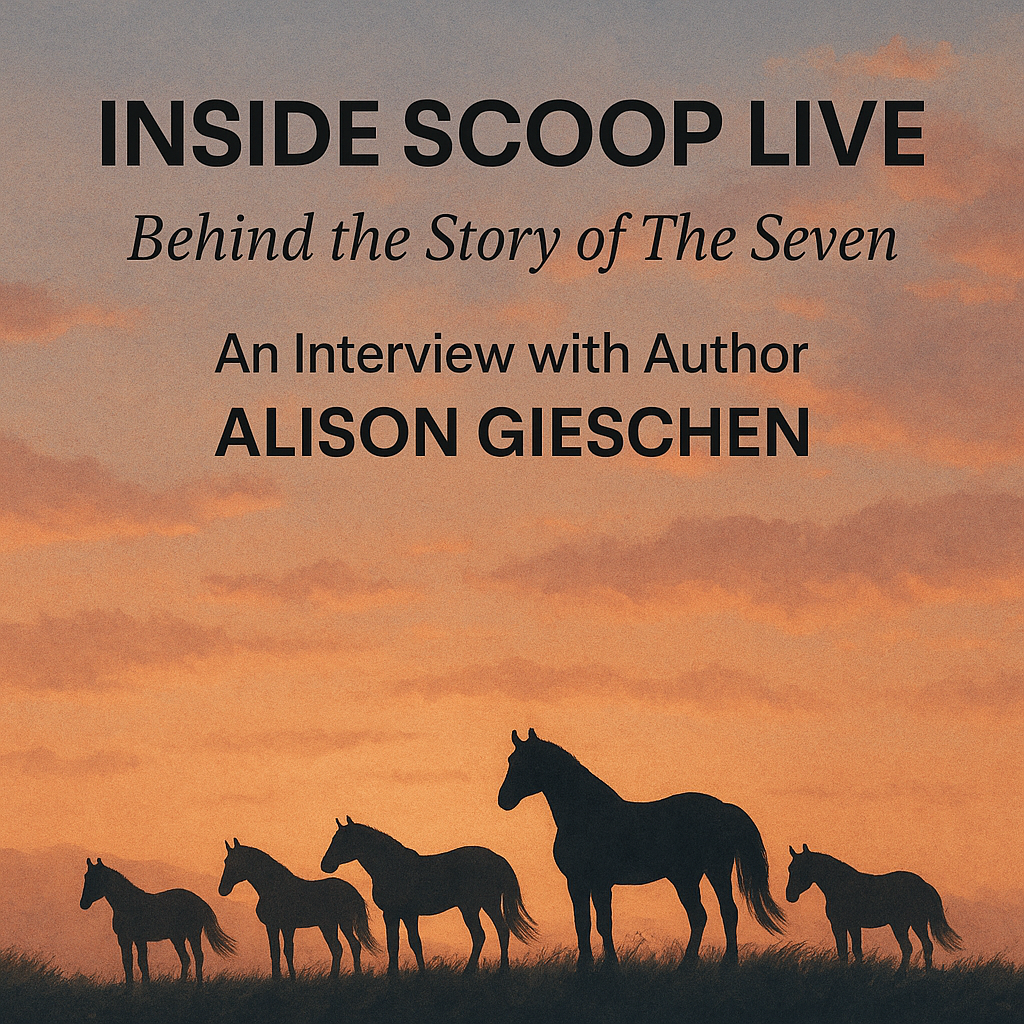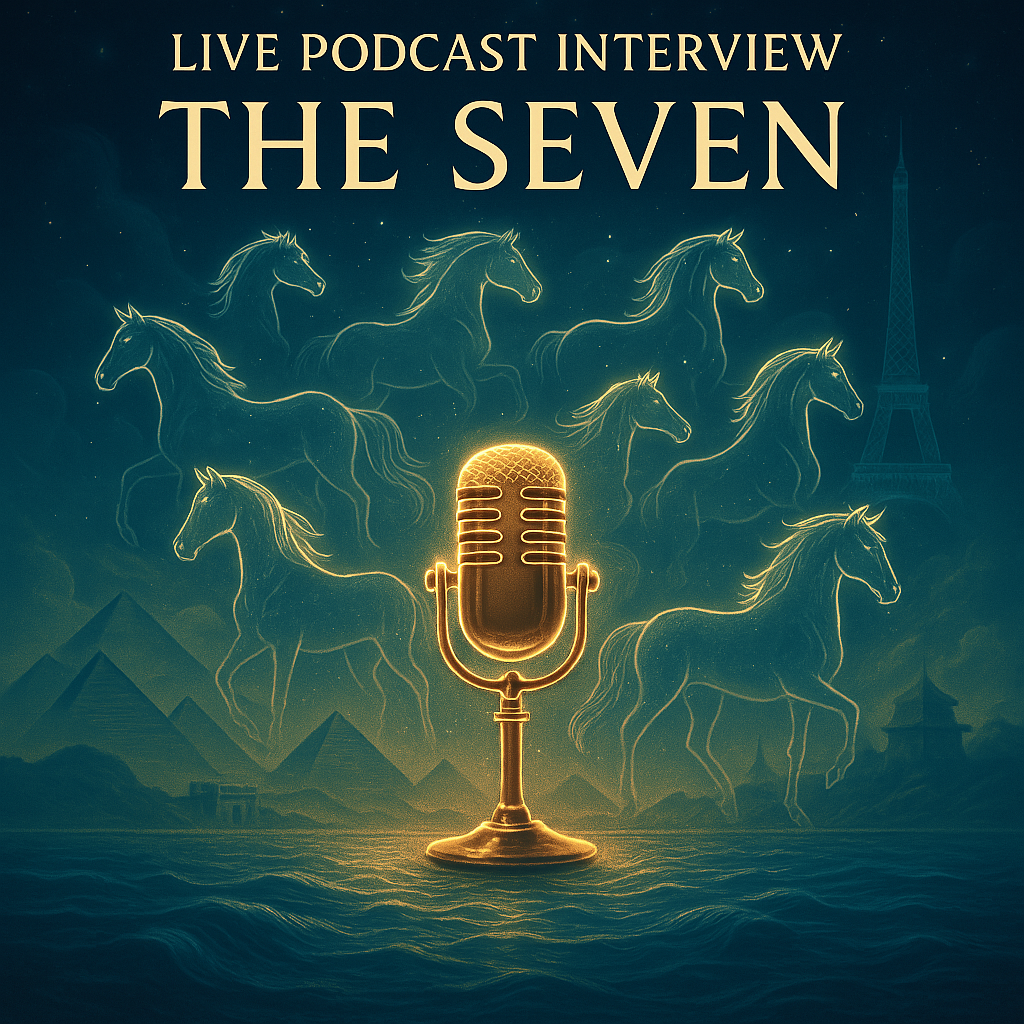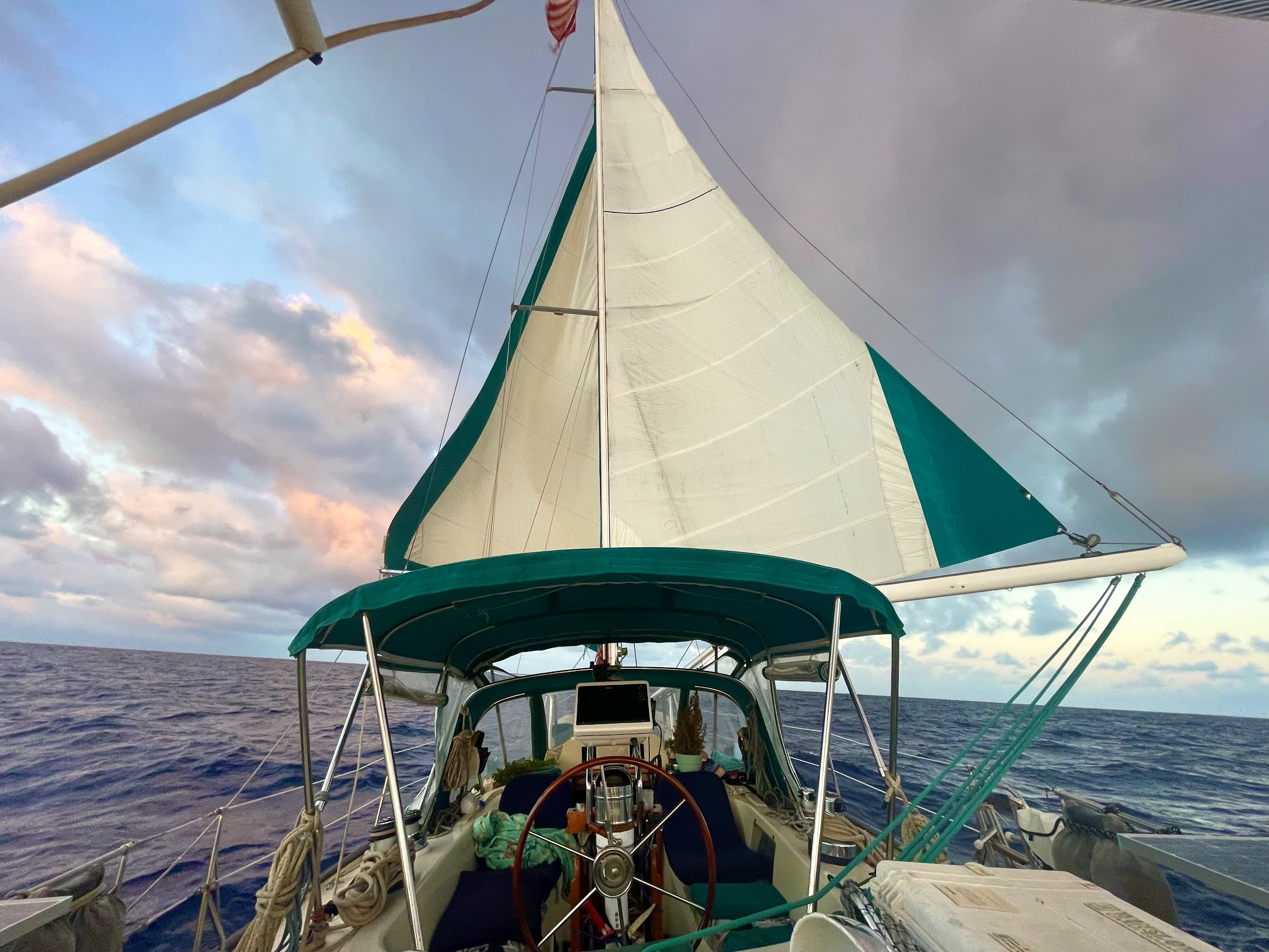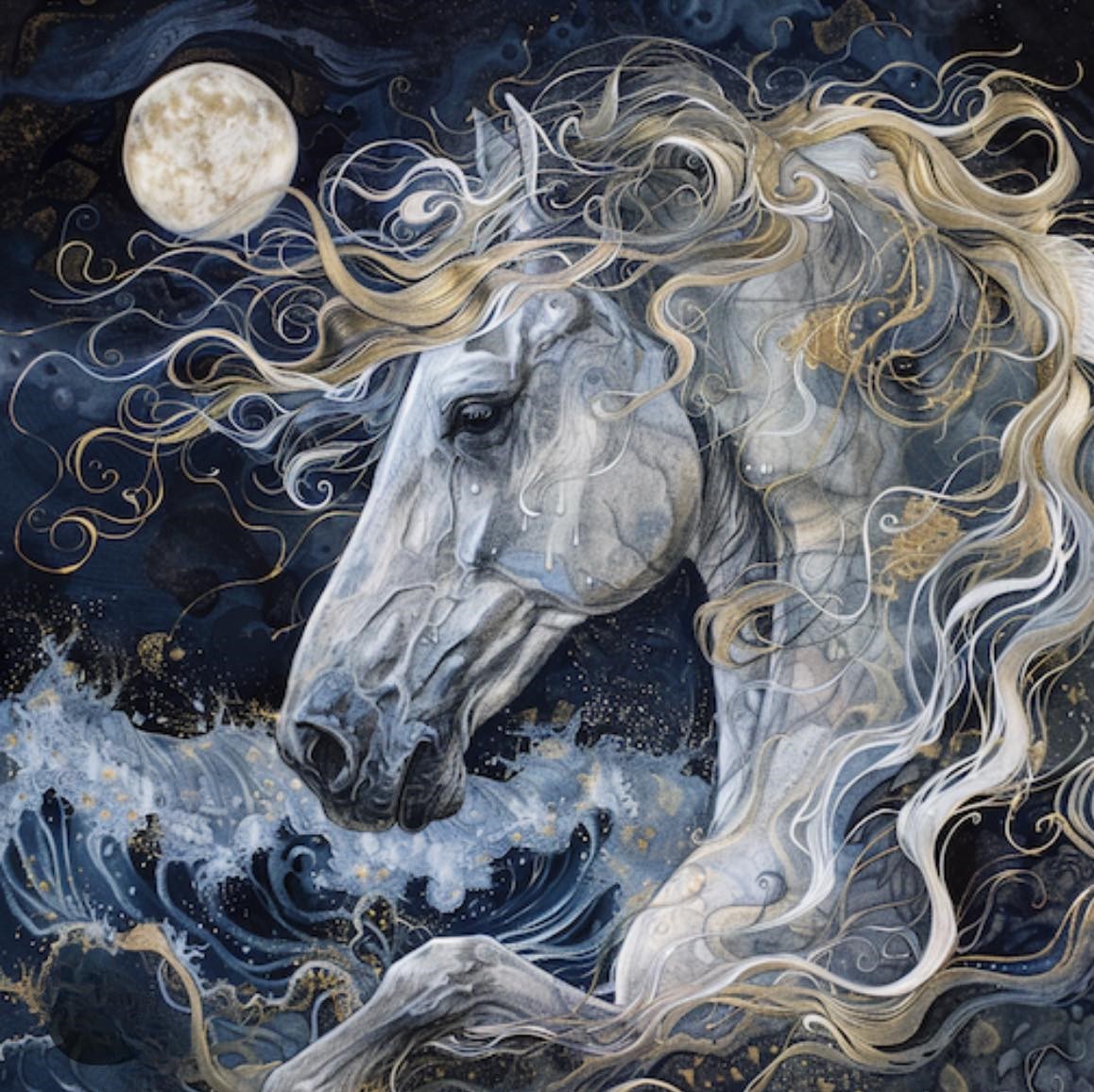
INTRODUCTION & INSPIRATION
What is The Seven about, and what inspired you to write a story that blends spiritual reckoning with personal transformation across so many different lives?

Thank you for this interview!
This story is about a lot of different things. It’s about humanity, horses, the common bonds we share, but mostly? It’s a story about the strength of humanity if we work together and realize what we have in common rather than focusing on our differences. The story came to me in a very vivid dream. In it, there were horses, my husband and I had a horse farm for 30 years, but we sold everything we owned and are presently circumnavigating the world on our sailboat – so even after leaving our land life, horses are still often in my dreams. However, this dream was very different. I had this overwhelming sense that they could see into my soul. When I woke up, I couldn’t shake the feeling. It was so powerful and real that I knew I had to write about it.
Why did you choose to have the horses, not divine beings, deliver judgment? What made them the right moral voice for this story?
As you know, horses have been a huge part of my life. My mom had me on the back of a horse before I could walk. As an adult, I ran a horse farm… worked with horses and people. What I learned is that horses don’t judge us the way humans do—they don’t care about our status or our mistakes. They respond to presence, to energy. They know when we’re afraid, when we’re pretending, or when we’re being authentic. So when I had the dream that inspired The Seven, it made perfect sense that the horses, not divine beings, would be the ones delivering judgment. In many ways, they already do. They mirror us. They see us for exactly who we are.
CHARACTERS & RELATIONSHIPS
Each horse is paired with a human from a vastly different background. How did you approach designing those pairings, and what did their diversity allow you to say about humanity?
Each human was paired with a horse – one that turned out to be exactly what he or she needed. Each horse is paired with a human from a vastly different background, a unique place somewhere in the world. Fun fact: all of the descriptions of the location and the people’s occupations are based on real places. I did a lot of research, so this is not just a story, it’s almost like historical fiction as I delve into the history of the characters’ cultures. Everyone who reads this story is going to learn a lot.
How did you approach designing those pairings, and what did their diversity allow you to say about humanity?
I wanted the pairing between each horse and human to feel purposeful… like their horse was the one – that person needed. The people in The Seven come from different corners of the world. On our travels to Europe, the Caribbean, Turkey, Africa… we’ve experienced so many different cultures, different belief systems, personal struggles and yet somehow it made me realize – we are all the same. In the book, no matter where they come from, each person faces a moment… a turning point where their horse becomes a mirror. It was important to me to emphasize that all humans share the same struggles.
You wrote seven incredibly different human characters—each one carrying pain, hope, and history. Was there one that felt especially close to your heart while writing, or one that challenged you the most?
All the characters are based on personal experience, but the one that touched me most was Justin Barone. His story echoes a part of my own life. Like Justin? I once stood on the edge of achieving an Olympic dream, and I know firsthand the heartbreak that comes when that dream slips away. But even more than that, Justin’s bond with his horse reflects something very real from my life. My family worked with a horse that had been abused. His name was Revlon, and through love, patience, and hours of building trust, we were able to heal him. In turn, he helped our family reach an incredible milestone… he carried my daughter to the World Equestrian Games, where she represented the United States. So, writing Justin’s journey was like opening a door to those memories. Revlon gave me a second chance at a dream, and Justin’s horse does the same for him. That relationship, that kind of healing—it’s something incredibly special. It was an absolute gift to be able to make that part of this story.
Did any of the characters surprise you—someone who evolved more than expected during the writing process?
Not really, because all of the characters surprised me. I didn’t have an endpoint in mind as their stories unfolded. As I was writing, each character developed like people do in real life. In many ways, each of the characters transformed into people I didn’t expect. Some of them didn’t make their transformation until the very end of the story, but that made their stories even more dramatic.
While you didn’t have an outline, did the structure evolve as you got deeper into the characters?
When I first began writing this story, I had no idea where it was going to lead. It was like watching a movie unfold in my mind – I was simply recording what I saw, and often, I was surprised by the twists and turns. It was surreal, really. And the ending took me totally by surprise. I couldn’t type quickly enough to keep up with the movie playing in my head. And going back and reading it? I still cry every time.
There are some powerful emotional standoffs in the book—moments where a human and a horse don’t agree on what the soul deserves. What was it like to write those scenes where judgment isn’t simple or unanimous?
Those scenes were some of the hardest—and most rewarding—to write. They forced me to look at the gray areas of human nature, to acknowledge that judgment isn’t always black and white. We like to think that goodness is obvious and that justice is clear-cut. But in reality, people are layered. We carry pain, we make mistakes, and we even sometimes, we even do the wrong things for the right reasons. Writing those standoffs between the horses and their humans was emotionally intense because the horses see everything, not just actions, but motives, regrets, love, and fear. They don’t judge on appearances or history. They judge based on what lies in the hearts of humans.
SPIRITUAL FRAMEWORK & SYMBOLISM
There’s a moment when the horses emerge from the forest to render judgment. Did you always envision the trial in such a symbolic, quiet form?
The entire story unfolded in a way that felt more like witnessing than creating. It was almost like the story already existed and I was just the one chosen to write it down. However, that moment when the horses emerge from the forest still gives me chills. It was powerful, but not because it was dramatic or loud. It was powerful because it was quiet.
At the time, I didn’t recognize the symbolism. It was only afterward, when I read back through the pages, that I saw how many layers there were. The forest, the silence, the gravity of the horses stepping forward – it speaks to how judgment in this story isn’t about spectacle. It’s about truth.
There’s no thunder or lightning in the verdicts—just emotional shifts. Was it difficult to create tension without traditional courtroom drama?
While the verdicts were quiet, no gavels slamming or dramatic declarations, there was actually a great deal of commotion from the heavens above those who were being judged. The tension didn’t come from shouting, it came from something much deeper: the immense gravity of what was happening. I didn’t rely on traditional courtroom drama because this wasn’t a courtroom. It was something more primal and ancient. The horses weren’t arguing a case… they were deciding, based on all they had witnessed and felt, whether their human’s soul was worthy of continuing.
The novel includes very real depictions of abuse, horse racing, slaughterhouses, and neglect. Were those scenes difficult for you to write emotionally?
Extremely. Those scenes were some of the hardest scenes to write. When you are as close to an animal as I am to horses, it hurts you on a visceral level to even think about the abuse they endure, let alone bring those realities to life on the page. But I knew it had to be included. I didn’t want to sensationalize it, but I also couldn’t look away from it.
Horses have been an enormous part of my life. I’ve witnessed their strength, their vulnerability, and their astonishing capacity to forgive. So writing about their suffering, especially at the hands of humans, was not just emotional; it was personal. But I feel it was also necessary.
Many of the humans forget the trial, but something in them changes. Do you think people can transform without remembering why?
I truly hope so. I believe that throughout our lives, subtle but powerful truths are planted in us – maybe in a dream, an encounter, through pain, or even in moments we don’t consciously remember. But just because we can’t recall the why doesn’t mean the transformation isn’t real. And that’s the heart of this story. It’s a message of hope that change is possible, even without fully understanding. This book is about that hope. Not just for the seven characters, but for all of us.
You weave in the seven virtues—love, joy, peace, patience, kindness, goodness, and faithfulness. Was that framework planned, or did it emerge as you wrote?
I didn’t sit down with a checklist of virtues, but I did have a deep sense that I wanted each human character to reflect something meaningful, something that represented the best of who we can be, even when we are broken. As each character began to take shape, I started noticing that their core traits aligned with those virtues. By the end of the writing process, I realized the virtues weren’t just themes—they were the heart of the story. It’s what made The Seven feel so personal and universal at the same time.
THE HORSES AS SPIRITUAL GUIDES
Your portrayal of the horses in the afterlife is vivid and luminous. How did you imagine that space, and what shaped your vision of their spiritual form?
I love this question because it touches on the SOUL of the book. Horses have always held a kind of quiet wisdom and deep presence in my life. Growing up with them, raising them, and working with them, I always felt there was something more going on behind their eyes. You just need to look into the eye of a horse and you know there is something magical there, a knowing, a connection. Almost like they were guardians of something ancient and good.
When I started imagining The Seven, it felt natural that they would exist beyond this world in a form even more radiant and powerful. What shaped that vision the most was my real-life bond with horses, the way they can mirror a person’s energy, and seem to see into your soul. It felt right to elevate that connection in a spiritual way. Making them chosen creatures in the story was just the next natural step. It was my way of honoring what they’ve ALWAYS meant to me.
Some of the most powerful insights in the book come from the horses themselves. How did you go about finding their voice, and what did you want them to reveal about humanity?
Giving the horses a voice was uncovering something that was already there, something I always felt when I was around them. Their voices are an echo of how we treat them. They are a reflection of what we are feeling. Their voices became the moral compass of the story. It reminds us that the heart of humanity is not found in power or status but in how we treat one another, how we rise after we fall, and how we keep showing up with hope.
MODERN PARALLELS & EMOTIONAL MOMENTS
You touch on modern disconnection through technology, greed, and celebrity. What critiques of today’s world felt most important for this story?
That theme of disconnection was something that kept rising to the surface as I wrote The Seven. I didn’t set out to critique the modern world, but as I dug deeper into each character’s life, I couldn’t ignore the patterns, like how technology, greed, fame, and even our pursuit of success can pull us away from what really matters.
One of the biggest topics I wanted to explore was how easily we’ve replaced real connection with artificial substitutes. We scroll through our phones instead of talking to others. We perform by saying what we think is most acceptable instead of revealing how we really feel. We’re bombarded with images of perfection and strive to be like them. As a result of this disconnection, I think the human race, as a whole, is lonelier than ever. I wanted to show how each character, despite their vastly different backgrounds, was wrestling with some form of isolation or emptiness. In contrast, we could see how their connection with a horse, something real and rooted, started to make that unravel.
Let’s talk about a moment that anchored the story for you. Was there a particular scene that brought everything into focus emotionally?
Absolutely. The moment that anchored the entire story for me was when each character entered heaven. Those scenes were powerful to write because they stripped everything away, all the titles, the failures, the achievements, the defenses, and revealed the raw, unfiltered truth of each soul. Each person’s reaction was so telling. Some stepped forward with awe, others with fear, and some with disbelief. But in that moment, without the noise of the world, their true essence came to light. You could see who they really were, not how the world defined them, but who they were at their core. That was emotional for me, because I realized I wasn’t just telling a story about seven people; I was telling a story about all of us.
The Father instructs the humans to share a memory or an apology with their horse. Why was that moment of direct accountability essential?
Up until that point, so much of their journey had been about being observed by the horses, by the Father, by the Son. But in that moment, the humans had to speak. They had to confront what they had buried, what they were proud of, and what they wished they could take back. It bared their true feelings, no filters, no justifications, just the raw truth of their relationship with the horse.
Without giving anything away, the story ends with a strong emotional note. What kind of feeling or reflection did you hope readers would carry with them after finishing the book?
So many people today have become disconnected from the natural world. We move so fast, we consume without thought, and we often forget that we’re part of something bigger. I wanted this book to be a reminder that the most important things are often the simplest: kindness, humility, love, and most of all… having a deep respect for this planet we call home. If The Seven can help someone slow down, reconnect with what matters, or even just look at an animal or a sunset with a little more reverence, then I feel like it’s done its job. This book is really a love letter to the earth and to the creatures who share it with us.
LOOKING AHEAD
What’s next for you? Are you working on another book?
What’s next? So much! Living on a sailboat and spending long stretches on the open ocean has been a true gift. I can write with no distractions, just the sound of the waves and the rhythm of the sea. I’ve been incredibly prolific in my writing. Right now, I have a magical mermaid tale in the works, Seanna, a story that’s especially close to my heart as my daughter’s middle name is Ariel. It’s being brought to life by an award-winning illustrator in England, and it’s aimed at early chapter book readers who love adventure and a touch of ocean magic.

I’m also working on the sequel to the first book in our ocean journey, Riding the Waves of Reality: Tales of Turmoil and Triumph. I dive into our sailing adventures where we explore the Mediterranean. This book is full of incredible destinations, crazy adventures, and, of course, the kind of chaos you can only have living on a sailboat.
I’m also a prolific blogger, so I regularly update our adventures on my sailmates.org website. We are departing this week for a 30-day passage across the Pacific. As we sail deeper into the remote islands of French Polynesia, I can already feel the stories forming. There’s so much beauty, mystery, and culture there. This next chapter? It’s going to be epic!
Check out our sailing adventures: www.sailmate.org
Alison Gieschen Author website: www.alisongieschen.com
![]()



Leave a Reply